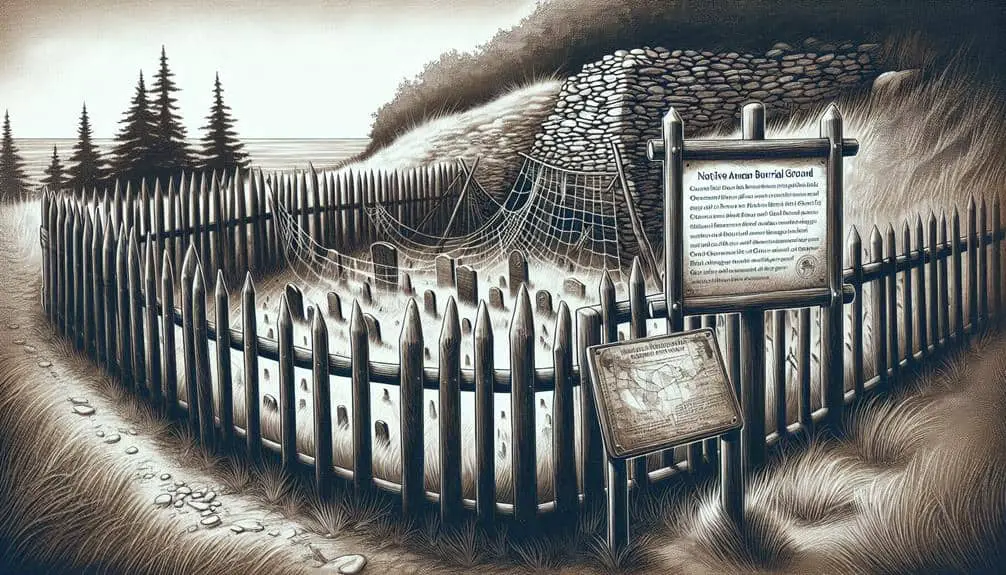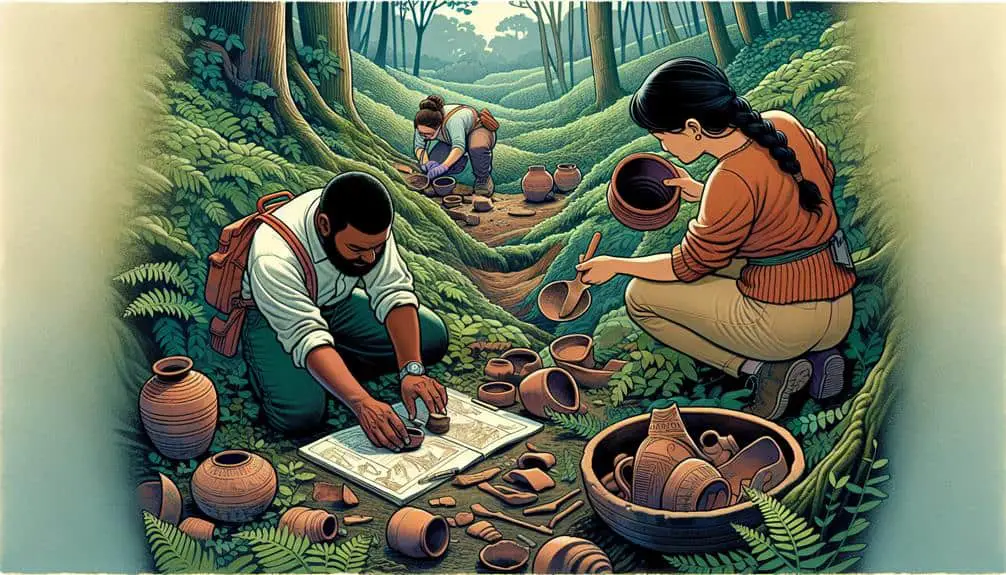Preserving ancient tribal remains in the United States is essential. It safeguards cultural heritage, offers insights into traditions, and connects communities with ancestors. Despite challenges like ethical dilemmas and cultural sensitivity, conservation efforts are pivotal. Native American settlements provide valuable windows into indigenous heritage, emphasizing diversity and community life. Strategies for ghost towns include evaluating history, stabilizing structures, and promoting education. Tourism can impact preservation and local economies, requiring sustainable practices. Understanding the significance and complexities involves a nuanced approach towards conservation. Learn more about this important endeavor.
Key Points
- Respect cultural beliefs and burial sites.
- Balance scientific research with cultural sensitivity.
- Preserve indigenous heritage and traditions.
- Implement sustainable conservation strategies.
- Engage communities in preservation efforts.
Importance of Preserving Tribal Remains
Preserving tribal remains is essential for safeguarding the cultural heritage and ancestral history of indigenous communities in the United States. These remains hold significant archaeological significance, providing valuable insights into the traditions, beliefs, and ways of life of the tribes that inhabited the land long before modern times. By protecting these sites, we aren't only honoring the past but also ensuring that future generations have the opportunity to learn from and appreciate the rich cultural tapestry of Native American tribes.
The cultural heritage embedded in tribal remains serves as a link to the past, connecting present-day indigenous communities with their ancestors and traditions. Through the preservation of these sites, we can better understand the evolution of these tribes, their interactions with the environment, and the societal structures that shaped their lives. Additionally, the archaeological significance of these remains can contribute to broader research efforts, shedding light on precolonial history and enriching our collective knowledge of the diverse cultures that have existed in the United States.
Challenges in Conservation Efforts
Preservation efforts encounter formidable obstacles when it comes to conserving ancient tribal remains in the United States. One of the primary challenges faced in these conservation efforts revolves around ethical dilemmas. The question of whether to disturb burial sites or sacred grounds in the name of research and preservation versus leaving them undisturbed out of respect for the deceased and their descendants is a complex and sensitive issue. Striking a balance between advancing scientific knowledge and honoring cultural beliefs poses a significant challenge for those involved in these conservation endeavors.
Cultural sensitivity is another critical aspect that complicates the preservation of ancient tribal remains. Respecting the traditions, beliefs, and practices of Native American tribes is paramount in these efforts. Understanding the cultural significance of these remains to the tribes and acknowledging their rights to control how their ancestors are treated adds layers of complexity to the conservation process. Maneuvering the intricate web of cultural sensitivities while endeavoring to protect and preserve these ancient tribal remains requires a nuanced approach and unwavering commitment to respecting indigenous cultures.
Significance of Native American Settlements
Understanding the historical and cultural significance of Native American settlements provides invaluable insights into the rich tapestry of indigenous heritage in the United States. These settlements serve as essential links to the past, offering a window into the customs, traditions, and ways of life of Native American tribes. The cultural heritage embedded within these settlements highlights the diversity and complexity of indigenous societies that once thrived across the country.
The historical significance of Native American settlements lies in their role as centers of community life, where social, spiritual, and economic activities intertwined to form cohesive societies. By studying these settlements, historians and archeologists can piece together the narratives of indigenous peoples, shedding light on their interactions with the land and with one another. Each settlement holds a unique story, contributing to the mosaic of Native American history and enriching our understanding of the interconnectedness between people and their environments. Embracing the historical and cultural significance of these settlements is vital for honoring the legacy of Native American communities and preserving their heritage for future generations.
Preservation Strategies for Ghost Towns
When considering the conservation of ghost towns, it's vital to evaluate the historical context and structural integrity to determine the most effective preservation strategies. Ghost towns hold significant archaeological importance, offering valuable insights into past ways of life. These abandoned settlements often serve as a time capsule, preserving the historical significance of a bygone era.
To guarantee the preservation of ghost towns, it's essential to prioritize the stabilization of structures and artifacts while maintaining the authenticity of the site. Implementing measures such as structural reinforcement, environmental monitoring, and controlled access can help mitigate deterioration and vandalism. Collaborating with local communities, historians, and archaeologists can also aid in developing sustainable preservation plans that respect the town's heritage.
Furthermore, promoting educational programs and guided tours can raise awareness about the cultural and historical value of ghost towns, fostering appreciation and respect for these unique sites. By recognizing their archaeological importance and historical significance, we can work towards safeguarding these remnants of the past for future generations to explore and learn from.
Impact of Tourism on Ancient Sites
Examining the influx of tourists on ancient sites reveals the potential impacts on their preservation and cultural integrity. The cultural significance of these sites can draw in large numbers of visitors, providing economic benefits to local communities. However, this increased foot traffic can lead to environmental sustainability challenges, such as erosion and damage to delicate structures. Balancing the preservation of these sites with the economic impact of tourism is important.
Community engagement plays an important role in mitigating the negative effects of tourism on ancient sites. By involving local communities in the management and decision-making processes, a sense of ownership and responsibility is fostered. This can lead to more sustainable tourism practices and a deeper respect for the cultural significance of the sites.
Frequently Asked Questions
What Legal Protections Are in Place to Prevent the Looting and Destruction of Ancient Tribal Remains in the United States?
To prevent looting and destruction of ancient tribal remains in the United States, legal protections exist. Ethical considerations and cultural significance drive these laws, safeguarding these valuable artifacts and sites for future generations.
How Do Modern Tribal Communities Feel About the Preservation of Ancient Tribal Remains?
Modern perspectives on the preservation of ancient tribal remains vary. Many tribal communities view these sites as essential to their cultural significance, advocating for their protection. Understanding and respecting these viewpoints is pivotal for effective preservation efforts.
Are There Any Ongoing Efforts to Repatriate Ancestral Remains to Native American Tribes?
You'll find ongoing repatriation efforts across the U.S., exemplified by the return of ancestral remains to Native American tribes. These endeavors recognize the cultural significance of these remains, fostering respect and honoring tribal traditions.
How Do Conservation Efforts for Ancient Tribal Remains Differ From Those for Other Historical Sites?
In conservation efforts for ancient tribal remains, cultural sensitivity is essential. Preservation challenges are unique due to spiritual significance. Conservation techniques must respect traditions. Community involvement is key for successful preservation and honoring ancestral heritage.
What Role Do Archaeologists Play in the Preservation of Ancient Tribal Remains in the United States?
In the preservation of ancient tribal remains in the United States, archaeologists are essential. They uncover cultural significance, utilizing diverse research methods. Their role extends to preservation techniques, addressing ethical considerations with care.



